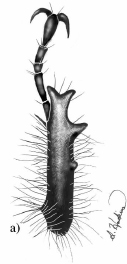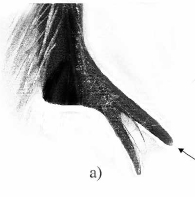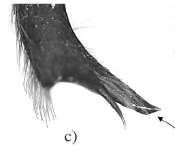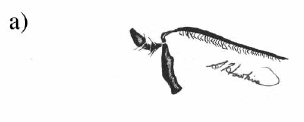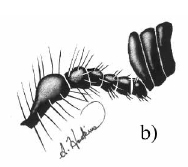
.
KEY TO GENERA AND SPECIES OF LICHNIINI
[From: Hawkins, S. J. 2006. A revision of the Chilean tribe Lichniini Burmeister, 1844
(Coleoptera: Scarabaeidae: Melolonthinae). Zootoaxa 1266:1-63.]
.
Males and females are distinguished in the following manner: In the genus Lichnia, the male protibia is slender (Fig. 3a), whereas the female protibia is broader for its entire length (Fig. 3b). In the genus Arctodium, the male tibial apex is modified into a long, pointed spine (Figs. 8a–c), whereas the female tibial apex forms only a short, blunt spine (Fig. 8d).
|
||||||||||||||
| . | ||||||||||||||
| 1. Galea at least 1/3 body length (Figs. 5b, 7b). Mandible rounded, without apical teeth
(Fig. 6b) ................................................ (5) Lichnia Erichson X 1´. Galea length less than 1/3 body length (Figs. 5a, 7a). Mandible dentate, with 2 apical teeth (Fig. 6a) .............................. (2) Arctodium Burmeister x
|
||||||||||||||
| 2. Eye canthus with fringe of long, pale setae ............................................................. Arctodium planum (Blanchard) 2´. Eye canthus with fringe of long, dark setae ......................................... 3 |
||||||||||||||
3. Body length from apex of pronotum to apex of pygidium 5.0–6.5 mm. Male metatibia
with apical spine shorter than adjacent metatibial spur (Fig. 8b) ................................................................... Arctodium mahdii Hawkins
|
||||||||||||||
| 4. Elytra as long as wide. Setae of posterior leg dark brown or black, never pale .............................................................. Arctodium discolor (Erichson) 4´. Elytra longer than wide. Setae of posterior leg variable, but never black ............................................................ Arctodium vulpinum (Erichson) |
||||||||||||||
5. Antennal club of males shorter than segments 1–6 (Fig. 4b). Occurs in Region IV
(Coquimbo) (Fig. 10) ...................... Lichnia gallardoi Gutiérrez
|
||||||||||||||
Author: Shauna Hawkins |
